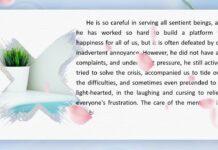Delusion Series, Part 5–Delusion, Wrong Views, and Ignorance
Hello, everyone! Welcome to this episode of the podcast, brought to you by the Australia Buddhas’ Practice Incorporated.
Today, we’ll dive deeper into the theme of “delusion,” uncovering its essence and revealing its equivalence to wrong views and ignorance. More importantly, we’ll explore how to break free from delusion’s shackles through the awareness of wisdom, paving the way to purity.
1. Delusion, Wrong Views, and Ignorance: Facets of Ignorance
Delusion is the ceaseless stream of thoughts in our minds, like an ever-spinning loom weaving stories detached from reality. To help us understand its roots, we often link delusion to “ignorance.” However, delusion is not merely ignorance—it’s a complex psychological phenomenon infused with greed, anger, ignorance, pride, doubt, and the conditioning of the six senses.
Delusion Stems from Ignorance, But Isn’t Identical to It
Ignorance is the root of delusion, the source of all erroneous perceptions and actions. Delusion is ignorance’s concrete manifestation in our minds, mixed with various afflictions and habits. Because the concept of “ignorance” feels abstract to most people, and even “delusion” is often misunderstood, many mistake their thoughts for “correct thinking” or valid cognition. For instance, someone might say, “What’s wrong with craving this? I got it!” This self-assured mindset is a hallmark of delusion.
Delusion Is Wrong Views
Why is delusion equated with wrong views? Because no delusion is ever correct. All delusional perceptions deviate from the true path, incapable of guiding us to our true goals. Wrong views are like a slanted line—seemingly aimed at the destination but leading us further astray. For example, if you want to pick up a cup but misjudge its location due to skewed perception, how could you succeed? This deviation from the true path is the essence of wrong views.
Delusion Is Ignorance
What results from wrong views? Ignorance. With skewed perceptions, your actions and judgments become “diseased,” unable to align with the true laws of reality. This diseased cognition is the essence of ignorance. Delusion, wrong views, and ignorance are fundamentally identical, all rooted in ignorance.
2. The Mechanism of Delusion: Sensation, Impulse, and Confidence
Delusion doesn’t exist in isolation—it’s intertwined with sensation and impulse, forming a web of afflictions that traps us in the mire of ignorance. These three are the convergence points of affliction, interwoven and driving us deeper into delusion.
Sensation: The Illusion of Definition
What is sensation? For example, tasting sweetness and thinking, “This is sweet,” or seeing an object and concluding, “This is iron.” These sensations aren’t the essence of things but labels and definitions formed through conditioning in our consciousness. When you first encounter something, you may not immediately define it, but soon you assign it a label, like “This is such-and-such.” This act of definition is itself ignorance, as it deviates from the true nature of things.
As the Buddha said, “Establishing perception as knowledge is the root of ignorance.” Once you define something, you’ve fallen into ignorance’s trap. The hallmark of sensation is unwavering belief—you confidently think, “What I sense is real!” This confidence fuels delusion.
Impulse: Uncontrollable Drive
What is impulse? When greed, anger, pride, or doubt arises, you lose control of your actions—this is impulse. For instance, when greed strikes, you must have something; when anger flares, you can’t hold back your temper. Impulse is like a runaway horse, charging forward with unstoppable force. This drive also stems from ignorance, from your attachment to and confidence in delusion.
The Common Thread of Delusion, Sensation, and Impulse: Confidence
Whether it’s delusion, sensation, or impulse, they share one trait—confidence. You believe your delusions are correct, your sensations are real, and your impulses are justified. This confidence keeps you trapped in the cycle of affliction, unaware of your predicament.
3. Breaking Delusion: From Awareness to Casting It Aside
Since delusion, wrong views, and ignorance are so deeply entrenched, how do we dismantle them? The answer lies in conditioning ourselves with wisdom and replacing ignorance with awareness. This is a path requiring patience and practice, but with persistence, liberation from delusion’s cage is certain.
Study the Harm of Delusion
To break delusion, first study it deeply. Delusion isn’t harmless fantasy—it’s the root of our suffering. As you observe delusion, you’ll progress through stages:
- Initial Awareness: You realize, “My mind is full of these thoughts!”
- Growing Awareness: You see, “These delusions are actually harmful!”
- Deep Awareness: You feel fear as delusion’s dangers become clear.
- Complete Awareness: You see through delusion’s falsehood, casting it aside like worn-out shoes.
This process takes time and repeated verification. Ask yourself, “Is this thought really correct? What will it lead to?” Through practical examination, you’ll see that delusion always brings suffering, not joy.
Condition Yourself with Truth
Recognizing delusion’s harm isn’t enough, as habits make it hard to “rein in.” Here, you must condition yourself with true wisdom. Each time a delusion arises, observe its cause, process, and outcome. Let reality show you: delusion is false and cannot bring true fulfillment. For example, reflect on a past instance of greed or anger and ask, “What was the result? Joy or pain?”
Through repeated verification, your awareness strengthens, like a muscle growing with use. When awareness reaches a certain level, delusion loses its allure.
The Power of Wisdom: Effective Every Time
Unlike delusion, wisdom works every time. When you act according to reality’s true laws, the results are always satisfying. Delusion, however, fails every time, exacting a cost. This contrast will incline you toward wisdom and away from delusion.
4. Practical Advice: Start Small, Build Awareness
Breaking delusion isn’t instantaneous—it requires starting small and accumulating progress. Here are practical suggestions:
- Observe One Thought: Choose a common delusion, like greed or anger, and observe how it arises and what it leads to.
- Question Yourself: Is this thought correct? Does it align with reality? What are its consequences?
- Practice Repeatedly: Like practicing a song, “sing” delusion’s harms to yourself, reinforcing its falsehood.
5. Abandon Delusion, Awaken Wisdom
Delusion is wrong views, is ignorance, and its root is ignorance. With sensation and impulse as accomplices, it traps us in a cage of affliction through false confidence.
Dear listeners, let’s observe every thought with awareness and examine every action with wisdom. As you accumulate enough awareness, delusion will be cast aside like worn-out shoes, and the light of wisdom will naturally shine. Let’s persevere together to achieve true peace and joy!
Thank you all!





